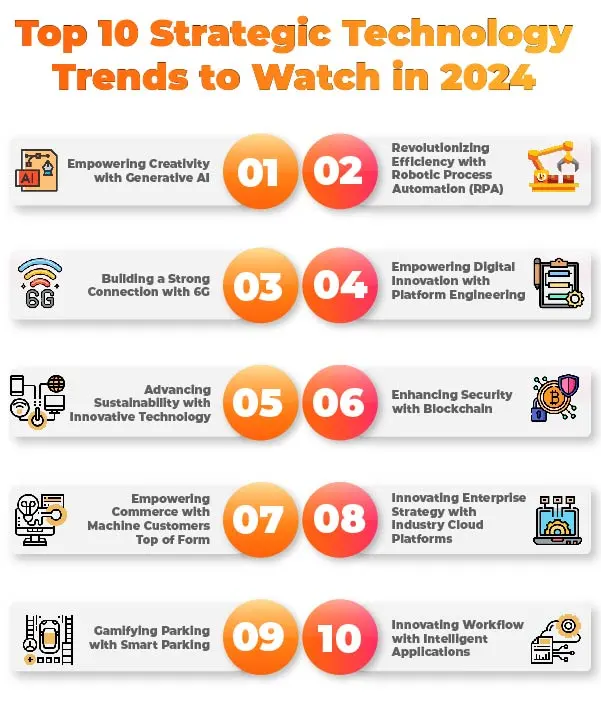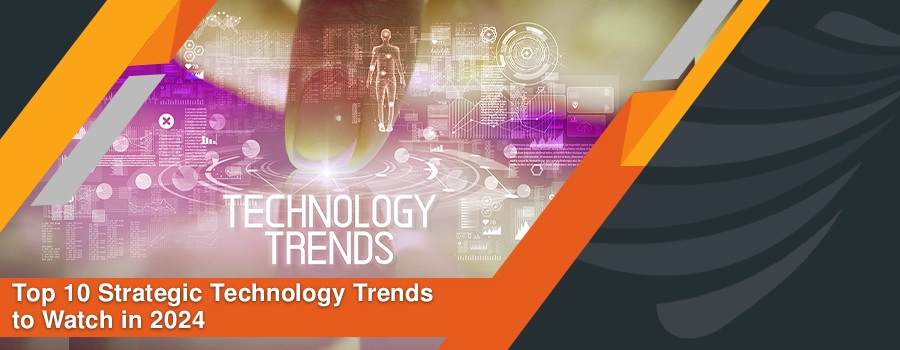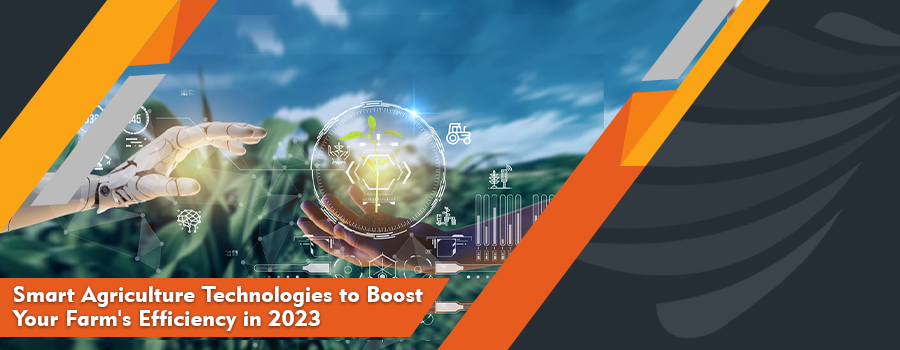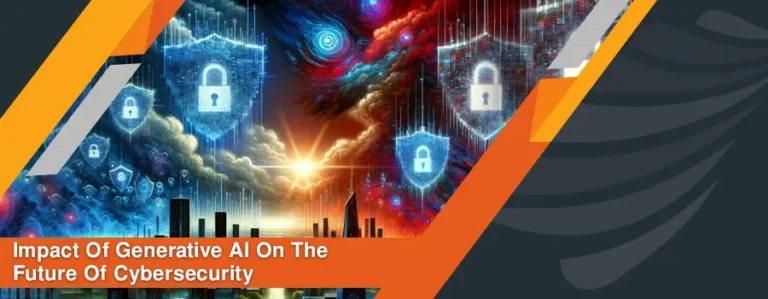Unlocking new opportunities is the cornerstone of enhancing lives, and we are here to provide you with a gateway into a new world of top 10 strategic technological trends. Join us as we delve into these innovations and allow you to redefine how you live, work, and process. Knowledge of new trends helps you to stay ahead in this competitive world and is important for your societal advancement and professional growth.

1. Empowering Creativity with Generative AI
The influence of generative AI is expected to increase significantly in the upcoming years. Generative AI helps to produce creative content by providing required text, images, synthetic data, and audio. It has shown a transformative impact by providing innovative solutions like video formation, upscaling images, and the generation of new ideas. One of the major examples is ChatGPT – a conversational AI model that has shown enormous popularity, reaching over 180 million users globally. Also, generative AI is predicted to democratize knowledge and training across various business roles, leading to new product formation and acknowledgment at an accelerated pace.
2. Revolutionizing Efficiency with Robotic Process Automation (RPA)
Robotic Process Automation (RPA) is a versatile technology with applications in different domains. Software bots automate repetitive risks and help to complete tasks on friction. Its integration reduces errors, enhances efficiency, saves time and money, and redirects the business’s focus toward value-added activities. One of its applications is automated payroll processing. By easily extracting details from handwritten timesheets, it efficiently processes payroll and enhances the overall process efficiency.
3. Building a Strong Connection with 6G
6G is the successor to 5G, revolutionizing connectivity by allowing better and faster machine-to-machine (M2M) communication and providing better support for immersive technologies. The 6g network will operate in untapped radio frequencies, providing low-latency communication faster than the 5g counterparts.
6G optimizes M2M interactions by enhancing network dependability. With the support of strong architecture, it can be implemented in heterogeneous cloud settings such as hybrid or private. Also, it can combine different technologies such as big data analytics and deep learning and is important in processing Internet of Things (IoT) and mobile data via high-performance computing (HPC) resources.
4. Empowering Digital Innovation with Platform Engineering
Platform engineering is the foundation for digital innovation and plays a role in crafting significant frameworks supporting the present technological landscape. Imagine an e-commerce platform that runs on the cloud and can easily manage spikes in user traffic during the busiest shopping seasons. This level of scalability and reliability is possible because of careful platform engineering, wherein architects create the underlying infrastructure to adapt easily to changing workloads. The platform’s integration of DevOps practices facilitates ongoing upgrades and enhancements, guaranteeing an evolving and proactive user experience.
The creation of contemporary mobile applications clearly illustrates platform engineering in action. Strong back-end platforms are created by engineers to enable the app’s functionalities and to easily interface with cloud-based services, allowing data processing, storage, and authentication. This well-coordinated strategy guarantees a seamless and safe user experience, demonstrating the critical role platform engineering plays in building the digital frameworks that spur innovation across various industries.
5. Advancing Sustainability with Innovative Technology
A key component of solving environmental issues and fostering long-term ecological balance is sustainable technology. For example, the increasing use of solar energy represents sustainable energy options. Photovoltaic cells, which make up solar panels, use sunlight to generate electricity without releasing damaging greenhouse gases into the atmosphere. This clean and sustainable energy source helps slow global warming while reducing dependency on fossil fuels. The persistent progress in solar technology, along with its declining costs, has rendered it a financially feasible and easily accessible choice for people, corporations, and governments across the globe.
Sustainable technologies influence green building techniques in addition to renewable energy. Energy-efficient architectural designs that use natural lighting and good insulation are prime examples of how environmentally conscious architects are. Another indication of the construction industry’s commitment to lowering carbon footprints is using sustainable materials like bamboo and recycled steel. Since buildings consume a large amount of energy worldwide, integrating this green technology reduces energy demand and encourages cities’ growth in a more environmentally conscious way.
6. Enhancing Security with Blockchain
Privacy violations and security breaches have become serious issues in this rapidly evolving digital era. One of the latest solutions to all this is blockchain technology. It operates as a tamper-resistant ledger, and with decentralized infrastructure, it provides a transparent and secure means of recording transactions. It dispenses information across a computer network, which helps lessen the risk of unauthorized access and data manipulation. For example, in the financial sector, the integration of blockchain technology creates an unexchangeable record of every exchange, ensuring the integrity of the transactions and fostering trust among users for enhanced security.
Additionally, the application of blockchain technology is not only reflected in finance but also in other fields. Like in the supply chain, it creates an absolute record of the whole journey of goods from manufacturing to dispatching to customers, providing protection against counterfeiting and enhancing the products’ authenticity. The feature of decentralization allows the elimination of single points of failure. This enhances security and makes it a formidable tool in fortifying the digital ecosystem against rapidly advancing security threats.
7. Empowering Commerce with Machine CustomersTop of Form
Machine Customers, also known as ‘Custobots,’ are non-human economic entities that can autonomously negotiate and make purchasing decisions in exchange for payments. The swift proliferation of connected products is driving this trend, with around 15 billion such devices expected to be released by 2028.
This revolution reflects a paradigm shift in the commerce industry and enhances the revenue potential with the expectation of reaching trillions of dollars by 2030.
8. Innovating Enterprise Strategy with Industry Cloud Platforms
Industry Cloud Platforms (ICPs) are rapidly emerging as a significant part of enterprise strategy. It is estimated that ICPs will be adopted by over 70% of enterprises by 2070 – showing a 55% increase from 2023. ICPs provide holistic solutions, meeting industry objectives via the incorporation of Platform as a Service (PaaS), Infrastructure as a Service (IaaS), and Software as a Service (SaaS).
These integrated platforms provide composable capabilities and include crucial features such as an industry data fabric, a repository of pre-packaged business functionalities, composition tools, and other innovations. The adaptability of ICP allows customization for specific industries and is further tailored to meet the distinctive needs of individual organizations. In addition to essential characteristics like an industry data fabric, a repository of pre-packaged business functionalities, composition tools, and other advances, these integrated platforms offer composable capabilities. Because of its flexibility, ICPs can be further customized to fit the unique requirements of individual organizations and tailored for industries.
For example, predictive maintenance, linked vehicle analytics, and supply chain optimization tools may all be easily integrated into an automotive ICP. This customized strategy guarantees the successful handling of problems unique to the industry, giving businesses a quick and easy fix. Businesses are beginning to recognize the importance of Industry-Specific Digital Transformation (ICPs), and these platforms have the potential to significantly influence the way technology is developed and move businesses in the direction of increased creativity and agility.
9. Gamifying Parking with Smart Parking
Gamifying Parking is the next evolution of smart parking solutions, transforming the traditional way of finding parking into an easy and engaging gaming experience. Drivers with augmented reality are guided by arrows to reach parking spots and get points if they safely park at the right spot.
With every use, their points increase, and they get bonuses, rewards, and badges. To illustrate, ParkSmart plans to utilize a gamified approach by integrating sensors, real-time data, and augmented reality. By adding gaming elements to the parking process, we can improve overall traffic, reduce the number of accidents, and provide users with an enjoyable experience.
10. Innovating Workflow with Intelligent Applications
Intelligent applications make suggestions and predictions for users and provide adaptive and personalized user experience. It analyzes real-time data, historical user interaction data, and other sources using AI algorithms. The intelligence of these applications relies on AI-based services such as machine learning, connected data, and vector data. The autonomy and adaptability of these applications make them effective for automating diverse work processes with enhanced efficiency.
To further elaborate, the talent shortage is one of the major issues organizations face. By leveraging artificial intelligence and behavioral analysis, intelligent applications can address talent shortages and help employees grow.
Final Thoughts
We expect a positive revolution with the integration of advanced technological trends. The strategic technological trends enhance our quality of life and allow us to explore unique opportunities. From employee retention to completing daily tasks, we can optimize our decisions and enhance our productivity. Integrating AI and robotic automation is taking us into a new world of technology with the promise to benefit humans extensively.





